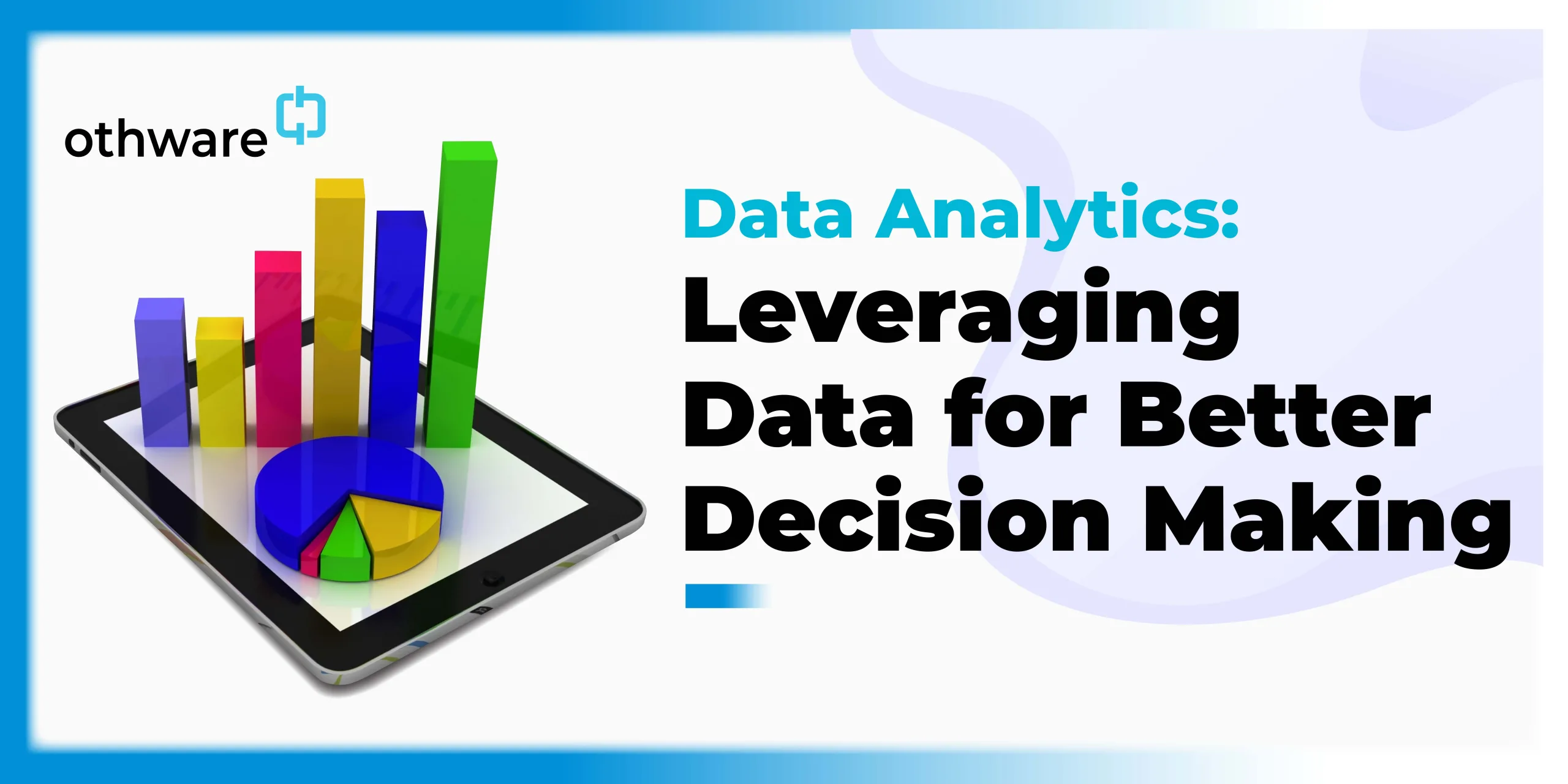Data analytics refers to examining vast volumes of data to uncover valuable insights, patterns, and trends that can drive informed business strategies. By harnessing the power of data analytics, businesses gain a competitive edge, optimize operations, enhance customer experiences, enhance decision making and in the long run achieve better outcomes.
Data analytics empowers decision-makers to move beyond gut instincts and anecdotal evidence. It allows organizations to extract meaningful information from diverse data sources, including customer interactions, sales transactions, social media, and operational metrics. With advanced analytics and techniques, businesses can transform raw data into actionable intelligence, leading to more accurate forecasting, improved operational efficiencies, better decision making and increased profitability.
Organizations can minimize guesswork and subjectivity by adopting a data-driven approach and making decisions based on facts, patterns, and statistical evidence. The insights derived from data analytics enable businesses to better their decision-making process by identifying market trends, understanding customer behaviour, optimising pricing strategies, personalising marketing campaigns, and mitigating risks effectively. Moreover, data analytics can uncover hidden opportunities and highlight potential areas for innovation, helping organizations stay ahead of the competition in today’s data-driven economy.
Key Concepts and Techniques
To effectively leverage data for better business decisions, it’s essential to clearly understand the key concepts and techniques involved in data analytics. Data analytics encompasses a range of methodologies and approaches that enable organizations to extract valuable insights from raw data.
Here, we will explore some fundamental concepts and techniques in data analytics.
Statistical Analysis
Statistical analysis forms the foundation of data analytics. It involves applying mathematical formulas and techniques to analyze and interpret data. Through statistical analysis, businesses can uncover patterns, relationships, and trends in their data, enabling them to make informed decisions.
Predictive Modelling
Predictive modelling utilizes historical data to make predictions about future events or outcomes. By building statistical models based on historical patterns, businesses can forecast customer behaviour, sales trends, demand fluctuations, and other crucial factors, enabling proactive decision-making and strategic planning.
Machine Learning
Machine learning is an advanced branch of data analytics that focuses on developing algorithms and models to learn from data and predict or take actions without explicit programming. These algorithms can automatically analyze vast amounts of data, identify patterns, and generate valuable insights. It is helpful in complex tasks such as image recognition, natural language processing, and anomaly detection.
Data Visualization
Data visualization involves presenting data visually, such as charts, graphs, and interactive dashboards. Effective data visualization enhances understanding, simplifies complex information, and facilitates data-driven decision-making. Through visually appealing and intuitive representations, decision-makers can quickly grasp insights and trends, enabling them to take action promptly.
Data Mining
Data mining involves discovering patterns and extracting valuable information from large datasets. It utilizes techniques from various disciplines, including statistics, machine learning, and database systems. Data mining helps organizations identify hidden patterns, correlations, and anomalies, which can inform strategic decisions and uncover untapped opportunities.
Big Data Analytics
With the exponential data growth in recent years, big data analytics has gained prominence. Big data analytics focuses on extracting insights from large, complex, and diverse datasets, often in real-time or near real-time. It requires specialized tools and techniques to handle big data’s volume, velocity, and variety, enabling organizations to derive valuable insights at scale.
So how can businesses use data analytics to better their decision-making processes? Explained below are the steps
Collecting and Storing Data Effectively
It’s crucial to collect and store data effectively to leverage data for better business decisions. Data collection involves gathering relevant and reliable information from various sources, while data storage focuses on securely organizing and managing that data for easy access and analysis.
Here are some strategies to consider:
Identify Relevant Data Sources
Determine the data sources most relevant to your business goals, including customer interactions, sales transactions, website analytics, social media platforms, IoT devices, and more. By understanding the specific data sources that align with your objectives, you can prioritize and focus your data collection efforts.
Implement Robust Data Collection Methods
Establish efficient mechanisms to collect data from identified sources. It may involve implementing data collection tools, integrating APIs for automated data retrieval, setting up surveys or feedback forms, or leveraging web scraping techniques. Ensure that data collection processes are standardized and consistent and adhere to privacy and data protection regulations.
Choose Appropriate Data Storage Solutions
Select suitable data storage solutions based on your requirements, like traditional databases, cloud-based storage platforms, or data lakes. Consider scalability, accessibility, cost-effectiveness, and integration capabilities when choosing storage solutions. Cloud-based platforms offer flexibility, scalability, and easy access to data, making them popular choices for many businesses.
Read Also: Benefits of Cloud Computing to Businesses.
Data Preprocessing
Data preprocessing plays a crucial role in data analytics as it ensures that the data used for analysis is accurate, consistent, and reliable. Raw data often contains inconsistencies, missing values, outliers, and noise that can affect the quality of analysis and subsequent decision-making. Preprocessing involves various steps to clean, transform, and prepare the data for analysis.
Here are some critical aspects of data preprocessing:
Data Cleaning
Data cleaning involves identifying and correcting dataset errors, inconsistencies, and inaccuracies. It may include handling missing values, removing duplicate entries, resolving inconsistencies in formatting or labelling, and addressing outliers. Cleaning the data helps to improve the accuracy and reliability of subsequent analyses.
Data Integration
In many cases, data collection may be from multiple sources and stored in different formats or structures. Data integration involves combining data from several sources into a unified form. This process ensures that all relevant data is available for analysis, providing a comprehensive view of the business operations.
Exploratory Data Analysis: Unveiling Insights and Patterns
Exploratory Data Analysis (EDA) is a critical step in the data analytics process that focuses on uncovering insights, patterns, and trends within the data. By visualizing and exploring the data, businesses gain a deeper understanding of the underlying patterns and relationships, which can inform better decision-making.
Some critical components of EDA include Data Visualization, Summary Statistics, Correlation Analysis, and Pattern Identification.
So after collecting the data, cleaning it, and storing it, what happens next?
Statistical Analysis
Statistical analysis plays a crucial role in leveraging data for better business decisions. It involves applying statistical methods and techniques to analyze data and draw meaningful inferences. Statistical analysis helps businesses uncover relationships, test hypotheses, and make data-driven decisions.
Here are some critical components of statistical analysis:
Descriptive Statistics
Descriptive statistics provide a summary of the main characteristics of the dataset. Measures like mean, median, mode, variance, and standard deviation offer insights into the data distribution’s central tendency, dispersion, and shape. Descriptive statistics help businesses understand the basic properties of the data and identify potential outliers or unusual observations.
Inferential Statistics
Inferential statistics involves drawing conclusions or making inferences about a population based on a sample of data. It uses sampling techniques and statistical tests to generalize findings from the sample to the larger population. Inferential statistics help businesses make predictions, test hypotheses, and estimate parameters with a certain level of confidence.
Regression Analysis
Regression analysis examines the relationship between a dependent variable and one or more independent variables. It helps businesses understand how changes in one variable affect another. Regression models can predict, forecast, and understand different factors’ impact on an outcome. Linear regression, logistic regression, and multiple regression are common techniques used in regression analysis.
ANOVA (Analysis of Variance)
ANOVA is a statistical technique that compares means across multiple groups or categories. It helps determine if there are significant differences between groups and which group(s) differ significantly from others. For example, ANOVA is helpful when comparing the performance of different marketing campaigns, analyzing the impact of various factors on sales, or assessing the effectiveness of other treatments.
Predictive Analytics
Predictive analytics is a powerful technique that leverages historical data and statistical modelling to forecast and anticipate future outcomes. As a result, businesses can make proactive decisions and optimize strategies by analyzing patterns and trends in the data. Predictive analytics offers several benefits, including improved forecasting accuracy, risk mitigation, and proactive decision-making. Here are the critical aspects of predictive analytics:
Feature Selection
Feature selection involves identifying the most relevant and influential variables or features that contribute to the outcome of interest. This process helps eliminate noise and focus on the most significant predictors. Techniques such as correlation analysis, stepwise regression, or feature importance rankings can aid in selecting the optimal set of features.
Model Selection and Building
Various predictive modelling techniques, such as linear regression, logistic regression, decision trees, random forests, or neural networks, can be employed. The model choice depends on the nature of the data, the relationship between variables, and the specific business problem at hand. Model building involves training the selected model on historical data and fine-tuning its parameters for optimal performance.
Forecasting and Prediction
With a validated predictive model, businesses can use it to forecast future outcomes based on new or unseen data. For example, predictive analytics can provide insights into sales forecasts, customer behaviour, market trends, demand patterns, or operational performance. These forecasts enable proactive decision-making, resource allocation, and strategy formulation to stay ahead in a competitive market.
Continuous Model Monitoring and Updating
Regularly monitor and update Predictive models as new data becomes available. It ensures that the models remain accurate and reliable as business conditions and dynamics change. In addition, continuous monitoring allows businesses to identify deviations or anomalies and make necessary adjustments to maintain model performance.
Leveraging data for better business decisions involves collecting and storing data effectively, preprocessing and preparing the data, conducting exploratory data analysis, performing statistical analysis, utilizing predictive analytics, and communicating insights through data visualization. By following these steps and harnessing the power of data analytics, businesses can unlock valuable insights, optimize strategies, and gain a competitive edge in today’s data-driven landscape.
Conclusion: The Future of Data Analytics
As data analytics evolves, the future holds exciting possibilities for businesses seeking to leverage data for better decision-making. Advancements in technology, emerging trends, and innovative approaches are shaping the future of data analytics. Here are key areas to watch for in the future:
- Artificial Intelligence and Machine Learning
- Natural Language Processing
- Internet of Things (IoT) Analytics
- Big Data Processing
The future of data analytics holds great promise, driven by emerging technologies and innovative approaches. Artificial intelligence, IoT, prescriptive, and augmented analytics will transform decision-making processes. However, organizations will need to navigate the ethical considerations, enhance data governance, and foster a data-driven culture to leverage the full potential of data analytics in the future.

Passionate about tech, a better writer than talker. Also a Content writer @ Othware.




